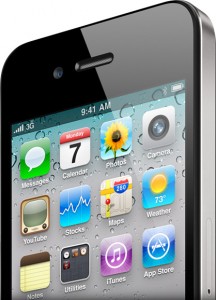Apple’s Retina Display included in the iPhone 4 has caused quite a stir this week, including claims that Apple is misleading consumers. However, a vision scientist contacted by The Loop says Apple has it right.  A Wired article earlier this week quoted Raymond Soneira, president of DisplayMate Technologies, who said the Retina Display was a “misleading marketing term” and that Steve Jobs “pushed it a little too far.”
A Wired article earlier this week quoted Raymond Soneira, president of DisplayMate Technologies, who said the Retina Display was a “misleading marketing term” and that Steve Jobs “pushed it a little too far.”
Not so, according to William H.A. Beaudot, Ph.D., a vision scientist who was a research associate at McGill University in Montreal and founder of KyberVision. “In my opinion, Apple’s claim is not just marketing, it is actually quite accurate based on a 20/20 visual acuity,” said Beaudot.
Beaudot explained that the magic number of 300 pixels per inch that Steve Jobs talked about in his keynote is closely related to the standard visual acuity (20/20). “A visual acuity of 20/20 means that a normal human eye can discriminate two points separated by 1 arc minute (1/60 deg). A visual angle of 1 arc minute seen from a distance of 1 foot corresponds to a dot size of about 89 micrometers or a pixel density of 286.5 dpi. Since the “Retina” display has a pixel density of 326 dpi (14% better than what we would expect from a 20/20 visual acuity at 1 ft), it would seem unfair and misleading to refute Apple’s marketing claim on this basis,” he said.
The optimal viewing distance quoted by Jobs is about 12-inches, but Beaudot says that viewing distance may be too conservative. He measured the comfort distance from his eye to the iPhone 3GS and found it to be around 18-inches. Even at this distance, Apple’s numbers hold up.
“At this comfort distance, Apple’s Retina Display would provide exactly the higher limit in angular resolution argued by Dr. Soneira (50 cpd). So Apple’s claim not only remains valid, but gets even stronger for any reasonable viewing distance beyond 12-inches,” said Beaudot.
Dr. Soneira also claims in the Wired article that the term Retina Display is more of a marketing term and is “superamplified imaginary nonsense.” Beaudot doesn’t agree.
“Since this display is able to provide a visual input to the retina with a spatial frequency up to 50 cycles per degree when viewed from a distance of 18-inches, it almost matches the retina resolution according to the Nyquist-Shannon sampling theorem,” said Beaudot. “As such, Apple new display device can be called without dispute a Retina Display. Could it get better? Sure, but so far this is the closest thing ever done in display technology for the consumer market that matches the human retina resolution.”
